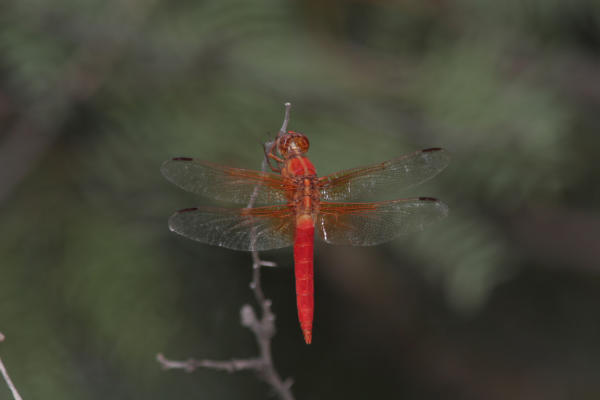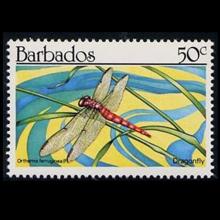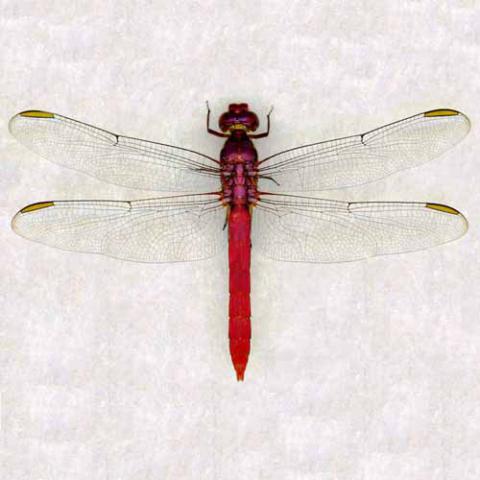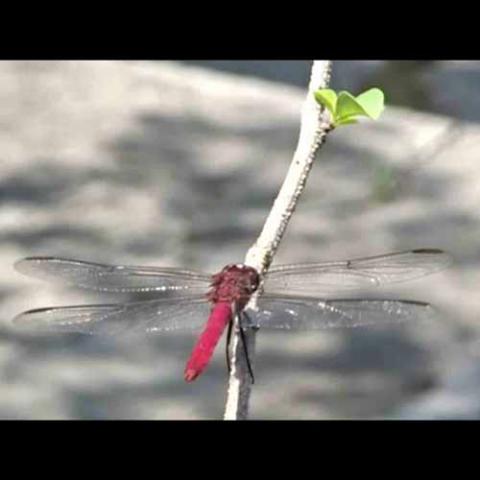NAMES
TAXONOMY
Barbados
Issued:
Stamp:
Orthemis ferruginea
Barbados
Issued:
Stamp:
Orthemis ferruginea
Barbados
Issued:
Stamp:
Orthemis ferruginea
Nature: Red dragonflies eat those skeeters
Five species live in area and show off bright colors
Gary Clark - Aug. 11, 2007, Updated: July 30, 2011 7:20 p.m.
A reader recently asked about a red dragonfly she saw in her yard. Astonished by the shimmering color, she wondered if it was unusual.
Red dragonflies aren't unusual in our area, but they certainly display unusual crimson colors. And like the legendary Red Baron, the red-scarfed World War I German fighter pilot Baron Manfred von Richthofen, red dragonflies zip through the air in twists and turns that would make any aviator envious. Dragonflies are in the Odonata order of aquatic insects that includes damselflies. They have three main body parts: head, thorax with wings, and abdomen. The thorax and abdomen often present striking colors, but the gossamer wings may also be decked with colors. They pose no harm to people but do great harm to mosquitoes, which they devour by scores. Hooray for dragonflies!
About five species of red dragonflies — call them miniature red barons — strafe ponds and waterways in Houston.
Needham's skimmer (Libellula needhami) shows up commonly at marshes, lakes and ponds from April to September. The male has a reddish-brown thorax and deep-red abdomen, which also shows a thin black line on the top or dorsal surface. The otherwise clear wings have a faint red tint to the leading edge.
The neon skimmer (Libellula croceipennis) reaches its easternmost range in Houston. It occurs principally in southern California, southern Arizona and west and central Texas from May to October. Appropriately named "neon," it has a lipstick-red abdomen that seems to throb like a light tube as the critter perches atop reeds beside ponds. The wings display an amber tone at the base, the part nearest the thorax.

The roseate skimmer (Orthemis ferruginea) shows up April to December. Similar to a neon skimmer, it comes in red and pink forms. We're more likely to see the pink form with a powdery-blue thorax and rosy-pink abdomen. The red form is entirely red. Both forms have clear wings with black stigmas near the tips.
Carolina saddlebags (Tramea carolina) show up throughout the year and have a black-tipped red abdomen. The word "saddlebags" comes from the broad red patches that blanket about a quarter of the base of the hind wings.
Red saddlebags (Tramea onusta) closely resemble Carolina saddlebags; they're present from February to November. The difference lies in their red patches, which cover only about a fifth of the hind wings, with a clear spot on the edge nearest the thorax. The forehead is generally red as opposed to violet in Carolina saddlebags.
Genus species (Animalia): Orthemis ferruginea
The Roseate Skimmer (Orthemis ferruginea) is a species dragonfly in the family Libellulidae. It is native to the Americas, where its distribution extends from the United States to Brazil. It is common and widespread. It is an introduced species in Hawaii.
The male of the species has a rose pink and red abdomen. The female has an orange-brown abdomen with clear orange veins and a brownish thorax with a light stripe down the back. The wings are normally clear except for brown pterostigmata at the leading edges. Its 46-55 mm in length with a wingspan of 35-44 mm long. Males are highly territorial, defending their territory aggressively against other male Roseate Skimmers that fly near.
It tolerates a wide range of habitat types, but usually requires open water. This can include disturbed and artificial water bodies, such as tanks and ditches. It can live in open or vegetated land. It breeds in the mud.
The skimmers or perchers and their relatives form the Libellulidae, the largest dragonfly family in the world. It is sometimes considered to contain the Corduliidae as the subfamily Corduliinae and the Macromiidae as the subfamily Macromiinae. Even if these are excluded, there still remains a family of over 1000 species. With nearly worldwide distribution, these are almost certainly the most often seen of all dragonflies.
Reference: Wikipedia, iNaturalist
Photo: P. Needle



